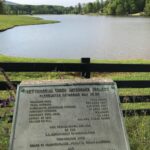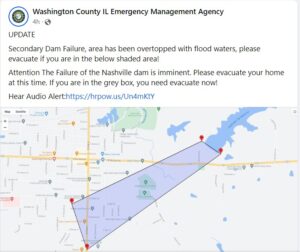
Amanda L. McPherson, Forsyth County Soil Conservation Technician, Natural Resources Conservation Service
You may have heard in recent weeks about dam failures following heavy rains. Two notable failures include Rapidan Dam in Minnesota, which began on June 25th, and the Nashville Reservoir in Illinois on July 16th.
The Rapidan Dam became loaded with debris after storms knocked trees and other materials into the river. After two days of high water levels and water flows that cut into the bank around the dam, a historic house collapsed into the river. An accumulation of over 100 years of sediment released in this failure event is projected to impact river health and fish habitats for years to come.

After 6 inches of rain in less than 24 hours, a dam in Nashville, Illinois overtopped, causing flooding downstream. Though this failure event was smaller than the one in Minnesota, travel routes were impacted, hundreds of people were evacuated, many businesses were closed, and roads, houses, and churches were damaged.
Dams are structures that hold back water to create artificial water bodies such as ponds, lakes, or reservoirs. Most residents of Forsyth County are familiar with Lake Lanier and Buford Dam, but there are many more dams in our county. In their National Inventory of Dams, the U.S. Army Corps of Engineers lists 49 dams in Forsyth County. The average age of these dams is 62 years, and 76% are considered High Hazard Potential dams by the Environmental Protection Department of Georgia (EPD). According to the Federal Emergency Management Agency (FEMA), high hazard potential “is a classification standard for any dam whose failure or mis-operation will cause loss of human life and significant property destruction.”

Hopefully, dams in our county are properly maintained and inspected as needed to ensure safety, but it is never too soon to be prepared for an emergency. If you live near a lake in Forsyth County, you live near a dam. If your neighborhood has a lake, you might be part of a homeowner’s association responsible for upkeep of a dam.
Once you know that you are near a dam, determine what kinds of impacts you should expect in an emergency. Are you on the upstream side of the dam or the downstream side? A dam failure by overtopping would impact the downstream side, but flood conditions may lead to water backed up higher than normal on the upstream side of the dam. Many of the dams in Forsyth County were created for sediment and flood control. A lake might have a ‘normal pool’ where water typically stays during normal to dry weather and a ‘flood pool’ that is reached during heavy rains. These lakes may rise as much as twenty feet during floods, so it is important to keep an eye on the weather and water conditions if you visit to fish, swim, or even just enjoy the scenery on the lake.

In addition to the impacts on your home, consider how a dam breach could disrupt your routes to and from work or school. You may not live in the breach zone of a dam, but what if the bridge you always take to work is out? What about loved ones, friends, and livestock? It’s a good idea to plan and practice alternate routes for evacuating or getting to the places where you’re needed. Repairing the damage a flood causes might take several months; having a plan in place will reduce stress on you, your loved ones, and your community.
Dams create beautiful scenery and great recreation opportunities, but they also come with responsibilities and risks. Make sure that you are aware of the risks to your home, workplace, and other areas you frequent. If you ever see a lake behaving strangely (i.e., water over the spillway, water level dropping quickly, etc.), water crossing a road from a lake, or other hazardous conditions, reach out to 911 immediately.